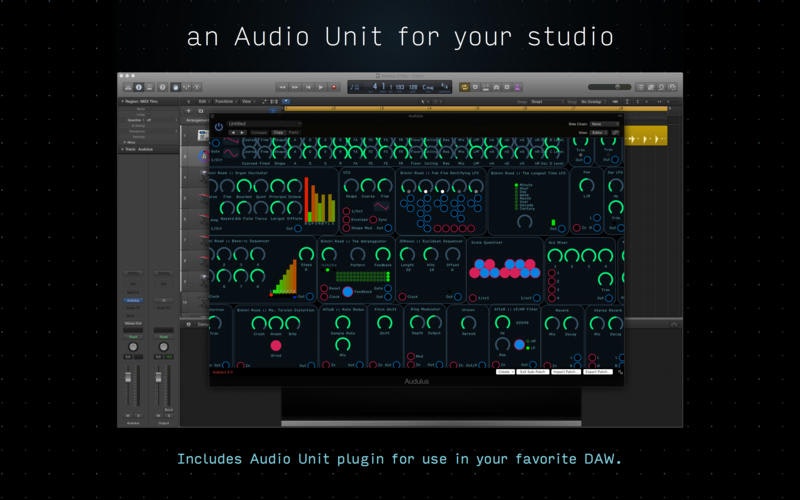
Perhaps Apple’s focus on more cross OS compatibility will eventually start to grease the wheels for these open source projects. It’s my strong impression that it can be a lot of work to maintain, update, and support a modular app on iOS/iPadOS versus other music creation apps.Įven open source projects like Pd which have widespread support in other operating systems have limited functionality and support in iOS/iPadOS. This can be a real concern with modular apps on Apple’s mobile devices as there’s a certain amount of attrition and it wouldn’t be very fruitful to invest your time in learning a modular app only to have it become another piece of abandonware. ScriptSONIC is an app that uses java script but the developer didn’t get enough traction so the app isn’t for sale anymore and their website and forum have been closed. Multi touch support, better and more comprehensive MIDI I/O, AUv3 support, and sample support are the features I eagerly await for in Audulus 4.

#AUDULUS DEMO PATCH#
It was very tedious to have to create a patch and then redo it into a playable patch. What I didn’t like about Audulus 3 was the lack of separation between the programming process and the GUI. The users on the Audulus forum are very knowledgeable and very helpful. One of the rarer and crucial functionalities that Audulus offers is a sample delay so you can utilize real-time feedback loops which are critical in many DSP operations such filters. More significantly I could understand how other people’s patches worked, learn from them, and modify or incorporate them into my own patches.
#AUDULUS DEMO HOW TO#
I personally like Audulus quite a lot because once I understood the significance of the lights and that I could put output components wherever I wanted in my patches to find out what was really happening versus what I thought was happening, I was able to learn how to make my own patches. The best modular environment is a very subjective evaluation. Mozaic and MidiFire cover the MIDI modular aspects of MIDI. The most difficult part of using the app is probably trying to figure out what all of the modules do.ĭrambo offers a lot of modular capability in a relatively easy to use format. MiRack has lots of modules with all sorts of options. Spectrum has a lot of granular and spectral functionality as do Alexander Zolotov’s apps (e.g.
#AUDULUS DEMO PLUS#
The Wotja app has lots of the functionality you’re looking for plus JavaScript. There is RunloopSound for learning and creating Csound. If you haven’t already checked it out, you might want to look into MobMuPlat, PdParty, Holonist.ist or zMors modular as they all have some Pd support. I hope it's still receiving active development. But if you plan to work inside the modular environment alone, Zmors is unique with it's IAA and AUv3 hosting ability. It doesn't always work a expected, especially when splitting cv and gate from midi modules. It doesn't have a great deal of modules - but it can host Auv3's and modulate exposed parameters. Finding them in modular environments are going to be even more difficult. Spectral is quite niche, Izotope and apeSoft specialize with it, but even on desktop there's not a great deal of spectral effects. There may be some granular modules - I don't know if it's got Clouds yet. Got lot's of real world modules like the Mutable Instruments catalogue. MiRack is closest to a hardware euroack workflow. Handles polyphony better than any other IOS modular.

Granular is on the roadmap, but not yet available. Plenty of maths, several sampler modules. It's fresh out so it's getting a lot of attention, and great roadmap for updates and improvements. Drambo is hands down the easiest/fastest modular workflow on IOS.


 0 kommentar(er)
0 kommentar(er)
